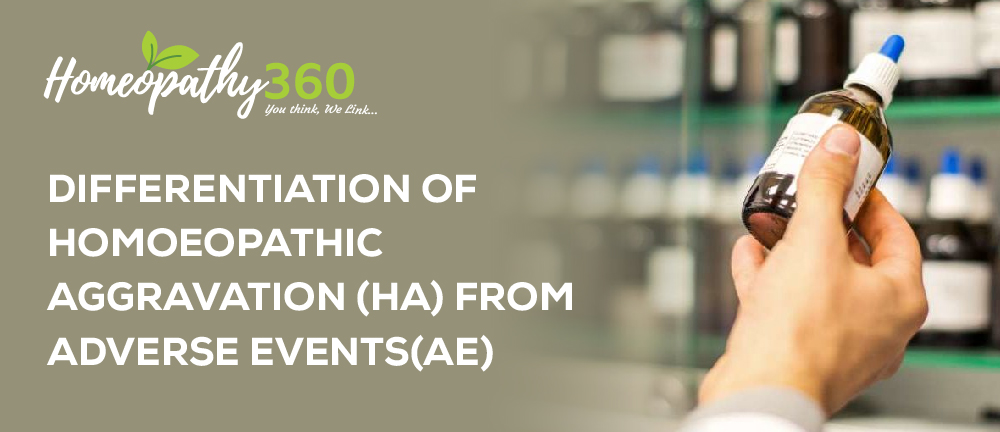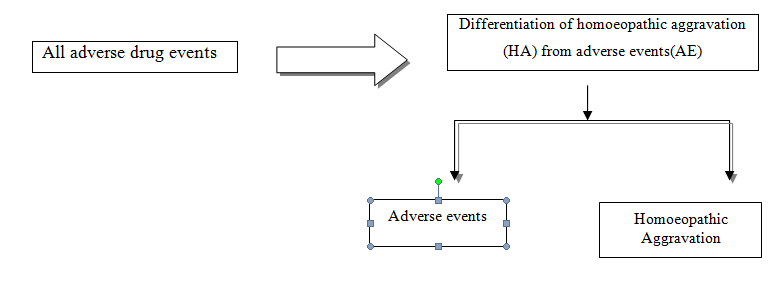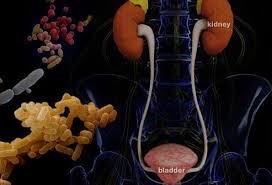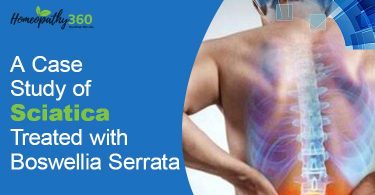
Adverse events and Homoeopathy
Abstract
Documentation of adverse events (AE) after medications is important to assess risk in form of treatment. Homoeopathic aggravation is a phenomenon which may be a part of these adverse events. But as we know homoeopathic aggravation (HA) is an indicator of good prognosis for the case. Hence, the responsibility of differentiating this parameter (HA) from genuine adverse reactions increases. Certain assessment criteria are required which will clearly demarcate the beneficial effect from the harmful ones.
Introduction
Homoeopathy is regarded as harmless intervention without any side effects. But from the laws of nature we know that for every action there will be a reaction. However, the risk profile of homoeopathic ultra-diluted medicines is minor and almost imperceptible. So while accessing patient’s response to the homoeopathic treatment (from several observational studies and surveys) it was found adverse effects from homeopathic treatment fluctuates between 2 and 11 percent 1.
Although Homoeopathy is regarded by many as effective and nontoxic intervention, but it may not be entirely risk-free. Controversy arises from the certain examples of homoeopathic treatment. In a case report which has been reported by Posadzki et al. as a case of homeopathy causing ‘heart disease and bladder cancer’, the patient was cured from his initial symptoms of vertigo and heart disease using homeopathic medicines. He was then presented 7 years later with cancer of the bladder. It is difficult to see how the causality of the cancer could be attributed to the successful treatment of the heart-condition. The cancer was subsequently treated using conventional treatment, the side-effects of which were successfully dealt with using homeopathy. The patient recovered, with no further complaint. Now this example is labelled as adverse effect of homeopathy. Another striking example was s a case of DRESS (Drug Rash with Eosinophilia and Systemic Symptoms) presented by Bernez et al. In this case, a homeopathic sleeping pill was taken on two occasions without any adverse event (4 months and 3 weeks before DRESS occurred). Here also the causative effect of homoeopathy remains a controversy. In another case a 9 month old baby was admitted to hospital after developing bullous pemphigoid due to 5 months homoeopathic treatment of atopic dermatitis. Report stated this severe situation occurred because the homeopath interpreted the worsening of symptoms as homoeopathic aggravation 2. Hence, the need of hour is to explore and compose criteria that may differentiate adverse event (AE) from homoepathic aggravation.
What is Homoepathic aggravation
According to our master Hahnemann the true homoeopathic aggravation – is an increase of the actual symptoms of the disease shortly after the administration of the medicine and the cause of it is the dose of the medicine being too powerful 3. Homoeopathic aggravation is a temporary worsening of existing symptoms following the administration of a correct homoeopathic prescription and is usually followed by an improvement 4. Smaller the doses of homoeopathic remedy, slighter and shorter will be the homoeopathic aggravation. However, the dose can scarcely or never be prepare so small that it can annihilate the uncomplicated natural disease, without development of homoeopathic aggravation occurs (understanding depends upon the perception of the physician). Hence, even the smallest possible dose of homoeopathic medicine is always capable of producing only the slightest homoeopathic aggravation, because it has the power of exciting symptoms bearing the greatest possible resemblance to the original disease 5.
Homoeopathic Aggravation in acute disease occurs during first few hours and is referred as a good prognostic sign and the acute condition may be probably cured (Aphorism 158). In Chronic Disease homoeopathic aggravation takes place during the six, eight, or ten days or at the end of treatment when the cure is almost or quite finished 5.As in literature the first example of homoeopathic aggravation by Hahnemann was the case of an individual affected with Colicodynia and the violent increase of the disease was evidently caused by the enormous doses of Veratrum swallowed 3.
The unique concept of homeopathic aggravation has similarities with the concept of ‘healing crisis’ that is common in other CAM (Complementary and Alternative medicines) therapies 6. A healing crisis is understood as temporary exacerbations on the way to more definite treatment 7.
According to several re-evaluations, the duration of aggravation depends on when the symptoms have started, the degree to which they have previously been suppressed or blocked, and overall vitality or ability of an individual to heal. Aggravation must be distinguished from detoriation of the patient’s illness according to the natural history of the disease and a worsening of symptoms due to the reduction of other medication 8. However, if the patient experiences a sense of wellbeing, simultaneously with deteriorations it’s a homoeopathic aggravation as a sense of wellbeing is a hallmark of a homoepathic aggravation 9.
What is Adverse drug event (ADE)
It is defined as any untoward medical occurrence that may present during treatment with a pharmaceutical product but which does not necessarily have a causal relationship 10. Now there is lot of incidences of adverse drug event in the field of Homoeopathy. According to homoeopathic philosophy if we consider the different type of aggravation then medicinal aggravation and disease aggravation of any case may be considered as Adverse drug event as per the definition of ADE. But the Homoeopathic aggravation will different from this as clearly demonstrated in the above lines.
How to distinguish between Homoeopathic aggravation and adverse effects
Hence, to differentiate homoeopathic aggravation and adverse event, patient reported reactions (outcome) may be classified into – No reactions, improvement of symptoms and worsening of symptoms 11. Next will be the evaluation to classify between adverse events which occurred independently and which are true homoeopathic aggravation.
| Differentiation of homoeopathic aggravation (HA) from adverse events(AE) |

Now, within this category of adverse events comes another category of reactions and i.e. adverse drug reaction (ADR) which may be defined as a reaction which is noxious and unintended, and which occurs at doses normally used in man for the prophylaxis, diagnosis or therapy of disease, or for the modification of physiology function 12, 13. The types of adverse drug reaction can be studies in two main headings, i.e., more common ADRs including type A and B reactions; and less common ADRs which include type C, D and E reactions 14. The characteristics of the types are as follows:
| Type A | Dose-related, related to a pharmacological action of drug , predictable from known pharmacology |
| Type B | Not dose-related -Uncommon -No relation to a pharmacological action of the drug |
| Type C | Uncommon -Long term exposure of drugs |
| Type D | Prolonged exposure to a drug |
| Type E | Termination of treatment |
The occurrence of adverse drug reaction in the field of homoeopathy is expected to be few provided the administration of the drug is lawful, ethical and according to the homoeopathic principles. But in some cases large amount (large doses of single medicine or multiple doses of several medicines) of homoeopathic medicines may cause direct harm to the patient and causes ADR. Long continued use of specific drugs may lead to the chronic bark dyscrasias, mercurial preparations and peruvian bark even if they are correctly indicated, but larger doses will put the patient to suffering for years 5.
Conclusion
Adverse events in homoeopathic practice including those that are interpreted as homeopathic aggravations are common. This demonstrates how important it is for clinicians to include the concept of adverse events in their theory and clinical practice. Adopting safety precautions will improve the reliability of the homeopathic profession and enhance patient safety. Consequently a surveillance program is recommended and a criterion needs to be framed.
References
- Thompson E, Barron S, Spence D. A preliminary audit investigating remedy reactions including adverse events in routine homeopathic practice. Homeopathy. 2004 Oct 1; 93(4):203-9.
- Tournier A, Roberts ER, Viksveen P. Adverse effects of homeopathy: a systematic review of published case reports and case series–comment by Tournier et al. International journal of clinical practice. 2013 Apr; 67(4):388.
- Lectures on theory and practice of homoeopathy by RE Dudgeon- chapter – the homoeopathic aggravation
- Kent J. Lectures on Homeopathic Philosophy New Delhi: B. Jain Publishers; 1900.
- Organon
- Pitchford P. Healing with Whole Foods. Asian Traditions and Modern. 3 ed. Berkely, California: North Atlantic Books; 2002.
- Calabrese C. Clinical research in naturopathic medicine. In: George Lewith, Wayne B Jonas, Harald Walach, editors. Clinical Research in Complementary Medicine. Edinburgh: Churchill Livingstone; 2002.
- Stub T, Salamonsen A, Alraek T. Is it possible to Distinguish Homoeopathic Aggravation from Adverse Effects? A Qualitative Study. Forsh Komplementmed; 2012; 19:13-19.
- Stub T, Salamonsen A, Kristoffersen A, Musial F. How to handle worsening of condition during treatment-risk assessment in homeopathic practice. Complementary Medicine Research. 2015; 22(1):30-5.
- Bavdekar SB, Karande S. National pharmacovigilance program. Indian pediatrics. 2006 Jan 17; 43(1):27.
- Stub T, Kristoffersen AE, Alræk T, Musial F, Steinsbekk A. Risk in homeopathy: Classification of adverse events and homeopathic aggravations–A cross sectional study among Norwegian homeopath patients. Complementary therapies in medicine. 2015 Aug 1; 23(4):535-43.
- Edwards IR, Aronson JK. Adverse drug reactions: definitions, diagnosis, and management. The lancet. 2000 Oct 7; 356(9237):1255-9
- World Health Organization. International Drug Monitoring: The Role of National Centres. Geneva: World Health Organization; 1972.
- Rohilla A, Yadav S. Adverse drug reactions: an overview. Int J Pharmacol Res. 2013; 3(1):10-2.
Author details
- Dr Ranita Nath, BHMS (Hons) – Programme assistant of Pharmacovigilance programme: working under Central Council for Research in Homoeopathy (CCRH) and posted in Dr. Anjali Chatterji Regional Research Institute (H) of Kolkata, West Bengal.
- Dr Partha Pratim Pal: BHMS (Hons), MD (Hom-Practice of medicine) – Research Officer (H)/ S-I under Central Council for Research in Homoeopathy and posted in Dr Anjali Chatterji Regional Research Institute (H), Kolkata. Completed postgraduation from National Institute of Homoeopathy, Kolkata.
- Dr Maurya Manjurani Sheopal, BHMS (Hons), MD (Materia medica) – Senior Research Fellow (H), under Central Council for Research in Homoeopathy and posted in Dr Anjali Chatterji Regional Research Institute (H), Kolkata. Completed postgraduation from National Institute of Homoeopathy, Kolkata.





